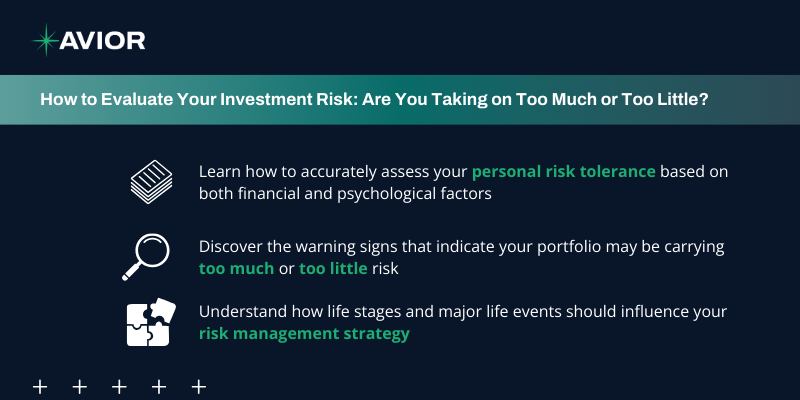How to Evaluate Your Investment Risk: Are You Taking on Too Much or Too Little?

When was the last time you really looked at your investment risk? For many of us, it’s like checking the air pressure in our tires, something we know we should do regularly but often push to the back of our minds. But understanding your risk exposure is arguably the most important aspect of successful investing. Too much risk could mean devastating losses that take years to recover from, and too little might leave your money crawling along when it should be racing toward your financial goals.
The truth is, finding your investment risk “sweet spot” isn’t about following generic advice or mimicking what worked for someone else. It’s about creating a personalized approach that aligns with your unique circumstances, timeline, and even your emotional makeup. Today, where volatility seems to be the only constant, having a clear understanding of your risk profile has never been more important.
Key Takeaways:
- Learn how to accurately assess your personal risk tolerance based on both financial and psychological factors
- Discover the warning signs that indicate your portfolio may be carrying too much or too little risk
- Understand how life stages and major life events should influence your risk management strategy
- Explore practical tools and techniques for measuring and adjusting risk in your investment portfolio
- Gain strategies for building a properly balanced portfolio that matches your risk tolerance
Understanding Risk Tolerance: Financial vs. Emotional
Your risk tolerance has two distinct components that often pull in opposite directions, your financial capacity to take risks and your emotional comfort with uncertainty.
The Financial Component
Financial risk capacity is objective and based on measurable factors. It considers your age, income stability, debt level, and time horizon for needing the invested funds. Someone with a secure job, substantial emergency savings, and decades until retirement naturally has a higher financial risk capacity than someone nearing retirement with limited additional income sources.
Ask yourself these questions to determine your financial risk capacity:
- How long until you need these funds?
- Do you have a stable income source?
- Is your emergency fund fully funded?
- What percentage of your overall wealth does this investment represent?
The answers reveal much about how much financial risk you can reasonably absorb.
The Emotional Component
Emotional risk tolerance is subjective and equally important. This measures your ability to stomach market volatility without making impulsive decisions. Even with a strong financial position, if market drops cause you sleepless nights and panic selling, your emotional risk tolerance is low.
Consider how past market downturns affected your behavior. Did you stay the course during the 2020 pandemic crash or the 2008 financial crisis? Or did you exit the market? Your historical reaction to volatility is often the best predictor of future behavior. Understanding this aspect of yourself is crucial because even the perfect investment strategy fails if you can’t stick with it through inevitable market fluctuations.
Warning Signs You’re Taking Too Much Risk
Recognizing when you’ve ventured too far into high risk territory is essential for long term investment success. Here are key indicators your portfolio may be overexposed:
Portfolio Volatility Causing Distress
When market dips lead to anxiety, lost sleep, or constant portfolio checking, your risk level likely exceeds your comfort zone. A properly balanced portfolio should allow you to navigate market fluctuations without significant distress. Remember, the emotional component of investing often drives poor decision making during volatile periods.
Concentration in Single Sectors or Assets
If more than 10% of your portfolio sits in individual stocks or a single sector, you may be assuming unnecessary concentration risk. Proper diversification remains one of the most effective risk management strategies. Check if recent market gains have unintentionally increased your allocation to high performing sectors, creating imbalance.
Leveraged or Speculative Positions
The presence of margin accounts, leveraged ETFs, or significant cryptocurrency allocations often signals excessive risk taking. These instruments can amplify losses dramatically during market downturns. While they have their place in certain sophisticated strategies, they should comprise only a small portion of most investors’ portfolios.
Signs You May Be Taking Too Little Risk
Being too conservative presents its own dangers, primarily the risk of failing to meet your long term financial goals. Here’s how to tell if you’re playing it too safe:
Cash Heavy Portfolio
When your investment accounts hold substantial cash positions for extended periods (beyond emergency reserves), you’re likely taking too little risk. While cash provides stability, it virtually guarantees negative real returns after inflation. This effectively means losing purchasing power over time, a significant but often overlooked risk.
Exclusively Using “Safe” Investments
If your portfolio consists entirely of certificates of deposit, money market funds, or short term bonds, you’re probably being overly cautious. These vehicles typically don’t provide enough growth to outpace inflation and taxes over long time horizons, especially for retirement planning.
Not Meeting Financial Targets
Perhaps the clearest indicator of insufficient risk is consistently falling short of your financial goals. If your portfolio’s growth rate isn’t on track to meet future needs (retirement, college funding, etc.), you may need to accept more market exposure to improve long term returns.
How Life Stages Impact Risk Management
Your appropriate risk level doesn’t remain static throughout life. Understanding how different life phases influence risk management is crucial for long term success.
Early Career Phase
In your 20s and 30s, your greatest asset is time. With decades until retirement, you can afford to take substantial investment risk because you have time to recover from market downturns. Your portfolio can reasonably hold 80% or more in growth assets like stocks or stock funds.
This stage is ideal for aggressive growth strategies as you can capitalize on compound growth over many years. Early career investors should generally worry less about short term volatility and more about maximizing long term returns.
Mid Career Accumulation
As you reach your 40s and 50s, your risk profile typically begins to moderate. While growth remains important, preservation becomes increasingly relevant. This often translates to portfolios with 60-75% growth assets and the remainder in more stable investments.
During this phase, many investors make the mistake of becoming too conservative too quickly. Remember that even at 50, you may have 15+ years until retirement and potentially 30+ years of life thereafter, still requiring significant growth.
Near or In Retirement
As you approach and enter retirement, your risk capacity generally decreases. With less time to recover from market downturns and a need for portfolio withdrawals, protection becomes more important. However, many retirees make the opposite mistake by becoming excessively conservative.
A balanced approach often works best, perhaps with 40-60% in growth assets. This approach acknowledges the reality that retirement may last 20-30 years, requiring continued growth to outpace inflation while providing needed income.
Practical Tools for Measuring Risk
Moving from theory to practice, several approaches can help you quantify and adjust your portfolio’s risk level.
Risk Assessment Questionnaires
Many financial institutions offer risk assessment tools that combine questions about your financial situation, goals, and comfort with various market scenarios. While somewhat simplistic, these provide a useful starting point for understanding your risk profile.
The most effective questionnaires address both objective factors (time horizon, liquidity needs) and subjective elements (emotional response to losses). Use these as a foundation, but recognize their limitations in capturing the full complexity of your situation.
Portfolio Analytics
Several online tools can analyze your existing investments and calculate risk metrics such as standard deviation, beta, and maximum drawdown. These quantitative measures provide objective assessments of your portfolio’s historical volatility relative to benchmarks.
Personal finance platforms like Morningstar or Riskalyze offer these analytics for both individual securities and your overall portfolio. This data helps identify whether your actual investment risk aligns with your intended risk level.
Professional Risk Analysis
For comprehensive risk evaluation, consider consulting a financial advisor with expertise in risk analysis. Professionals can conduct sophisticated portfolio stress testing, showing how your investments might perform under various market scenarios.
They can also help translate abstract risk metrics into practical terms, helping you understand what a “20% drawdown” actually means for your financial goals and emotional wellbeing.
Building a Properly Balanced Portfolio
Once you’ve identified your appropriate risk level, the next step is constructing a portfolio that aligns with this profile.
Asset Allocation Fundamentals
The foundation of risk management lies in proper asset allocation, distributing investments across major categories like stocks, bonds, real estate, and cash equivalents. Each asset class responds differently to economic conditions, providing diversification benefits.
Your allocation should reflect both your risk tolerance and investment timeline. A common starting point is the rule of 100: subtract your age from 100 to get a rough percentage for growth assets. While overly simplistic, this illustrates how allocation typically becomes more conservative with age.
Diversification Within Asset Classes
Beyond basic asset allocation, diversification within each category further reduces risk. Within your stock allocation, this means spreading investments across various sectors, company sizes, and geographic regions. For bonds, it means varying maturities, credit qualities, and issuers.
Remember that true diversification comes from owning assets that don’t move in perfect tandem. International stocks, for instance, often follow different cycles than domestic markets, providing valuable diversification benefits.
Regular Rebalancing
Over time, market movements will naturally alter your portfolio’s allocation as some investments outperform others. Regular rebalancing, perhaps annually or when allocations drift more than 5% from targets, maintains your intended risk level.
Rebalancing essentially enforces a “buy low, sell high” discipline, trimming positions that have grown overweight and adding to underperforming assets. This mechanical approach removes emotional biases from the process.
Work With Us
Finding your investment risk sweet spot isn’t a one time exercise but an ongoing process that evolves with your life circumstances and financial goals. By understanding both the financial and emotional components of risk tolerance, recognizing warning signs of improper risk levels, and implementing practical tools for measurement and management, you can build a portfolio that aligns with your unique situation. Remember that the right amount of risk isn’t about maximizing returns at all costs or avoiding volatility entirely, but rather about striking the balance that keeps you on track toward your goals while allowing you to sleep well at night.At Avior, we specialize in helping clients develop personalized risk management strategies that align with their specific goals and comfort levels. Our advisors use sophisticated risk assessment tools to evaluate your current portfolio and recommend adjustments that better match your true risk profile. We understand that managing investment risk isn’t just about numbers, it’s about creating a sustainable approach that you can confidently maintain through various market conditions and life stages. Contact Avior today for a comprehensive risk evaluation and discover how our tailored approach to wealth management can help you achieve your financial objectives with confidence.
No Comments
Sorry, the comment form is closed at this time.




